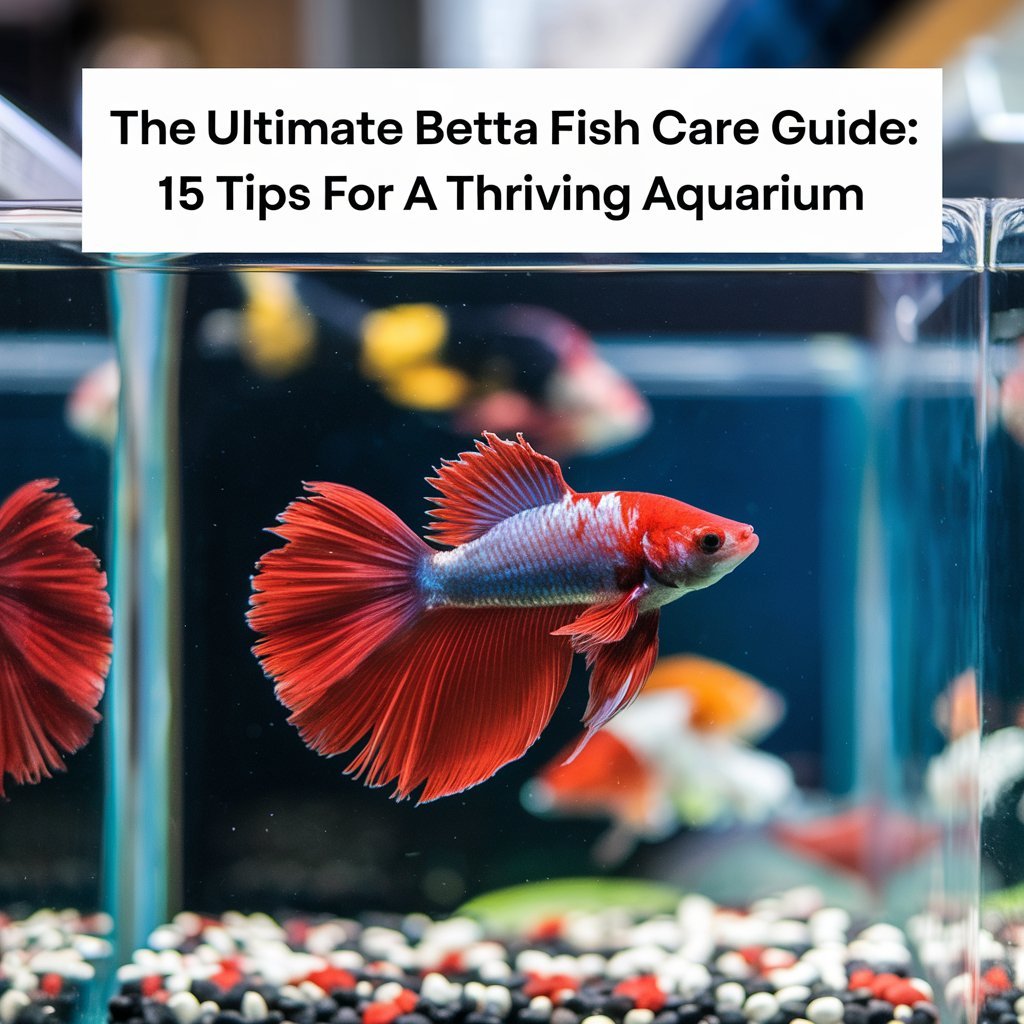The Ultimate Betta Fish Care Guide: 15 Tips for a Thriving Aquarium
If you’re new to betta fish care or looking to improve your existing routine, making certain is crucial to guarantee your pet’s well-being. You’ve likely heard that betta fish can thrive in small spaces, but is that really the case? The truth is, their tank environment plays a substantial role in their overall health.
By choosing the right tank size, maintaining ideal water conditions, and providing a balanced diet, you can dramatically reduce your betta’s stress levels. But what other factors should you consider to create a happy and healthy environment for your pet?
In A Nutshell

- Provide a spacious tank with a minimum capacity of 5 gallons and ample hiding places for a stress-free environment.
- Maintain a stable water temperature between 76°F to 82°F (24°C to 28°C) using a high-quality aquarium heater and thermometer.
- Regularly test water quality, aiming for 0 ppm ammonia, 0 ppm nitrite, and below 10 ppm nitrate levels.
- Offer a varied diet including protein-rich foods, commercial pellets, and vegetables, and limit food servings to twice a day.
- Perform regular tank maintenance, including 25-50% weekly water changes, gravel cleaning, and decoration cleaning to prevent common health issues.
Choosing the Right Tank Size
When choosing a tank for your betta fish, it’s crucial to select a size that meets their specific needs.
A minimum tank size of 5 gallons is recommended, but larger tanks are even better. This is because betta fish can grow up to 3 inches in length and require ample space to swim.
You’ll also want to ponder tank shapes and aquarium styles.
Traditional rectangular tanks are great for betta fish, as they provide a long swimming area. However, other tank shapes like bow-front or corner tanks can also work well.
Some aquarium styles, such as long and low tanks, can provide a unique swimming experience for your betta fish.
Avoid small tanks or bowls, as they can be detrimental to your betta fish’s health.
These small spaces can lead to stunted growth, stress, and a weakened immune system.
By choosing a larger tank, you’ll be providing your betta fish with a healthy environment that promotes growth and well-being.
Always prioritize your betta fish’s needs when selecting a tank, and opt for a size that will give them the space they need to thrive.
Tank Location and Placement
You’ve chosen the perfect tank for your betta fish, but now it’s time to think about where to put it.
The location and placement of your tank can markedly impact your betta’s health and well-being. When deciding on a location, consider the amount of direct sunlight the area receives.
Avoid placing your tank near a window with direct sunlight, as this can cause algae growth and fluctuations in water temperature. East- or west-facing windows are ideal for window placement, as they receive gentle, indirect sunlight.
Corner placement is also a good option, as it provides stability and reduces the risk of the tank being knocked over.
Additionally, placing your tank in a corner can help to reduce vibrations and noise from the surrounding environment. Avoid placing your tank near heating or cooling vents, fireplaces, or drafty windows, as these can cause sudden changes in water temperature.
Proper Water Temperature
After carefully considering your tank’s location and placement, it’s time to turn your attention to another critical factor that directly affects your betta fish‘s health and well-being: water temperature.
Betta fish thrive in warm water, with a recommended temperature range of 76°F to 82°F (24°C to 28°C). You’ll want to avoid placing your tank near drafty windows, air conditioning vents, or extreme temperatures, as these can cause temperature fluctuations.
To maintain a stable water temperature, consider using a high-quality aquarium heater and a thermometer to monitor the temperature.
Avoid creating thermal gradients, where the temperature varies markedly between different areas of the tank. This can stress your betta fish and lead to health issues.
By maintaining a consistent temperature, you’ll create a comfortable environment for your betta fish to thrive. Be sure to research and choose a heater suitable for your tank size, as over- or under-heating can be detrimental to your fish’s health.
Regularly check the temperature to certify it remains within the recommended range.
Water Quality Monitoring
Monitoring your betta fish’s water quality is essential for its survival, and doing so is imperative to check several key parameters regularly.
To maintain ideal water quality, you’ll need a water testing kit. This kit usually includes tests for ammonia, nitrite, and nitrate levels.
These tests help you detect any issues that can harm your betta fish. Using the water testing kit, check for ammonia levels, as this can be toxic to your fish. Ideally, you want an ammonia reading of 0 parts per million (ppm).
Also, test for nitrite and nitrate levels, aiming for a nitrite level of 0 ppm and a nitrate level below 10 ppm.
Alkalinity levels should also be monitored. This parameter measures the water’s ability to neutralize acid and should be maintained between 5 and 20 dKH.
Testing the water regularly helps you stay on top of these parameters, enabling you to take corrective action when needed. It’s also essential to monitor water pH and adjust it as necessary, with most betta fish thriving in slightly acidic to neutral pH (6.5-7.5).
Choosing the Best Filter
When it comes to maintaining peak water quality, a reliable filter is essential for your betta fish’s health and well-being.
You’ll need to choose a filter that’s suitable for your tank size and type. There are several filter types to ponder, including internal, external, and hang-on-back filters.
Internal filters are compact and easy to install, while external filters offer more advanced features and better filtration. Hang-on-back filters are a popular choice for betta tanks, as they’re easy to install and provide good water circulation.
When selecting a filter, ponder the flow rate and make sure it’s adjustable to prevent strong currents that can stress your betta.
You should also look for a filter with a built-in biological filter to help maintain a healthy balance of beneficial bacteria. If you’re looking to upgrade your filter, ponder adding a sponge filter or a canister filter, which offer improved filtration and increased water circulation.
Regular filter maintenance is also pivotal to guarantee prime performance and keep your betta healthy.
Creating a Balanced Diet
A well-planned diet is key to keeping your betta fish healthy and thriving.
You’ll want to provide a varied diet that includes a mix of protein-rich foods, such as bloodworms, brine shrimp, and daphnia.
Commercial betta pellets or flakes can serve as a staple, but it’s vital to supplement with live or frozen foods to guarantee your betta gets all the necessary nutrients.
Food variety is pivotal to prevent nutritional deficiencies and boredom.
Rotate your betta’s food every few days to keep things interesting and prevent over-reliance on a single food source.
Consider adding vegetables like zucchini or spinach to your betta’s diet, as they’re rich in fiber and vitamins.
Supplementation options are also available to enhance your betta’s diet.
Vitamin and mineral supplements can be added to their food to boost their immune system and overall health.
However, be cautious not to over-supplement, as this can cause more harm than good.
Always follow the manufacturer’s instructions and consult with a veterinarian if you’re unsure about the optimal supplementation options for your betta.
Feeding Frequency and Amount
Feeding your betta fish the right amount and frequency is crucial for maintaining its health and preventing digestive issues. Overfeeding can lead to water quality problems, while underfeeding can cause malnutrition.
As a general rule, feed your betta fish 2-3 times a day, only as much as it can consume within 1-2 minutes. A good starting point is to provide 2-3 high-quality pellets or 1-2 bloodworms per feeding session.
However, this may vary depending on the size and age of your betta fish, as well as its individual appetite.
It’s also essential to fast your betta fish for one day a week to allow its digestive system to rest and prevent overfeeding. By monitoring your betta fish’s eating habits and adjusting the feeding frequency and amount accordingly, you can ensure it stays healthy and thriving.
Providing Hiding Places
Planning a balanced environment for your betta fish involves more than just managing its diet.
Providing hiding places is essential to create a stress-free space for your pet. In the wild, betta fish use plants, rocks, and other underwater structures to hide from predators.
You can replicate this environment by adding a hiding cave or two to your tank. These caves can be made of plastic, ceramic, or other aquarium-safe materials and come in various shapes and sizes.
When choosing a hiding cave, consider the size of your betta fish and the tank. A cave that’s too small can be stressful, while one that’s too large can be overwhelming.
Decorative rocks can also be used to create hiding places. You can arrange them in a way that creates small crevices and caves for your betta fish to hide in.
Make sure to leave enough space for your betta fish to swim freely and easily access the hiding places. By providing these hiding places, you’ll create a comfortable and secure environment for your pet to thrive in.
Aquarium Decor and Plants
Adding live plants to your aquarium not only enhances its aesthetic appeal but also provides numerous benefits for your betta fish.
Live plants help maintain water quality by absorbing excess nutrients and waste products, which reduces the risk of algae growth and keeps the water clean. They also provide your betta with a natural environment, complete with hiding places and visual barriers.
When designing your aquarium’s aquatic landscaping, consider the type of plants that thrive in low-light conditions, as betta fish prefer dimly lit environments.
Choose plants with varying textures and colors to create visual interest and depth. Decorative accents, such as driftwood or rocks, can also be used to create hiding places and add visual appeal.
Some popular live plants for betta aquariums include Java moss, Anacharis, and Amazon swordplants.
These plants are easy to care for and can thrive in a variety of water conditions. By incorporating live plants and decorative accents into your aquarium’s design, you can create a natural and visually appealing environment for your betta fish to thrive in.
This will help reduce stress and promote overall health and well-being.
Maintaining Proper Ph Levels
Proper pH levels are crucial for maintaining a healthy environment for your betta fish, as even slight deviations can cause stress and discomfort.
To guarantee the ideal pH range for your betta fish, which is between 6.5 and 8, you’ll need to use a pH testing kit. These kits are widely available and can be found at most pet stores that sell aquarium supplies.
Using a pH testing kit, you’ll be able to determine if your tank water is acidic or alkaline.
If the pH level is too high or too low, it can disrupt the acid-alkalinity balance, causing stress to your betta fish. If the pH level is too high, you can add peat or driftwood to the tank to lower it, while adding crushed coral or baking soda can help raise it if it’s too low.
It’s essential to note that betta fish can adapt to changes in pH levels, but sudden changes can still cause stress.
Regular Water Changes
Regular water changes are a crucial part of maintaining a healthy environment for your betta fish.
You should change 25-50% of the tank water weekly to prevent the buildup of toxins. Before making a water change, test the water to determine its pH, ammonia, nitrite, and nitrate levels. This will help you identify any issues that need to be addressed.
When performing a water change, use a gravel vacuum to remove debris and waste from the substrate.
Replace the old water with dechlorinated water that matches the tank’s temperature and pH. You can use a water conditioner to remove chlorine and chloramines from the tap water.
If you’re using a new tank, consider using a fishless cycling method to establish a healthy colony of beneficial bacteria.
This method involves adding ammonia to the tank and monitoring its conversion to nitrite and then nitrate. Regular water testing will help you determine when the tank is cycled and ready for your betta fish.
Avoiding Tank Mates
While it may be tempting to introduce tank mates to keep your betta fish company, it’s generally not recommended.
Betta fish are naturally solitary and territorial, and they can be quite aggressive when it comes to defending their space. Introducing other fish to the tank can lead to stress, fin nipping, and even injury or death.
Some species are more aggressive than others, and it’s best to avoid them altogether.
Fin nipping is a common problem when keeping betta fish with other fin-nipping species, such as tiger barbs or serape tetras. These fish will constantly nip at your betta’s fins, causing stress and discomfort.
Even if you introduce peaceful species, there’s still a risk of conflict.
Betta fish are aggressive species and may see other fish as intruders. To avoid any potential problems, it’s best to keep your betta fish alone in the tank. This will guarantee they live a happy and stress-free life.
By avoiding tank mates, you can minimize the risk of conflict and keep your betta fish healthy and thriving.
Always prioritize your betta’s well-being and keep them solo.
Recognizing Common Diseases
Betta fish can live a long, healthy life if you provide them with ideal care. However, even with proper care, diseases can still occur.
Vital to recognize common diseases early on to prevent them from becoming severe. One common disease in betta fish is fungal infections, which can cause white, cotton-like growths on the fish’s body. These growths can be a sign of a fungal infection, and if left untreated, can spread quickly.
You should also be aware of bacterial outbreaks, which can cause a range of symptoms including labored breathing, lethargy, and loss of appetite.
Bacterial outbreaks can be caused by poor water quality, overfeeding, or introducing infected fish to the tank. Regular water changes and proper filtration can help prevent bacterial outbreaks.
When inspecting your betta fish, look for signs of disease such as labored breathing, lethargy, or visible growths on the body.
Monitor your fish’s behavior and appearance closely, and be prepared to take action if you notice any unusual signs of illness. Early detection is key to preventing diseases from becoming severe and ensuring your betta fish lives a long, healthy life.
Quarantine and Treatment
When a disease is suspected, you’ll need to quarantine your betta fish to prevent the disease from spreading to other fish, if you have a multi-fish tank.
Quarantine involves isolating your betta in a separate tank with its own equipment to stop the disease from spreading. This separate tank should have the same water conditions and temperature as the original tank to minimize stress on your betta.
In the quarantine tank, you’ll need to monitor your betta’s condition closely and administer medication as needed.
Medication options include antibacterial, antifungal, and antiparasitic treatments, which can be used to treat a range of diseases. To guarantee success, follow the manufacturer’s instructions carefully when using medication to avoid harming your betta.
Disease prevention is key to successful betta fish care.
Regular water changes, proper nutrition, and a clean environment can all help prevent disease.
By quarantining your betta and administering medication promptly, you can help prevent the spread of disease and confirm your betta recovers quickly.
Always research the specific disease and treatment options before administering medication to confirm the best possible outcome for your betta.
Regular Tank Maintenance
Maintaining a clean and healthy environment is vital for your betta’s well-being, and it starts with regular tank maintenance.
You’ll need to perform partial water changes, typically 25-50% every week, to remove waste products and excess nutrients.
Use a gravel vacuum to siphon out debris and waste from the substrate during these water changes. Gravel cleaning is pivotal, as it prevents the buildup of toxins and keeps your betta healthy.
In addition to water changes and gravel cleaning, you’ll also need to clean your tank decorations.
Decor cleaning is often overlooked, but vital to remove algae and bacteria that can accumulate on decorations.
Use a magnetic algae scraper to remove algae from the glass walls of your tank, and gently scrub decorations with a soft-bristled brush to remove any debris.
Regular tank maintenance will help keep your betta healthy and thriving.
By staying on top of these tasks, you’ll be able to prevent many common health issues and create a happy, thriving environment for your betta.
Regular maintenance will also help extend the life of your tank equipment.
Frequently Asked Questions
Can Betta Fish Be Kept in a Bowl With No Filter?
You can keep a betta in a bowl with no filter, but it’s vital to maintain it regularly to prevent water quality issues. This setup can also lead to betta loneliness, so provide plenty of stimulation.
How Often Should I Clean the Gravel in My Betta Tank?
You’ll want to clean the gravel in your betta tank every 1-2 weeks, as part of regular aquarium hygiene. Siphon out debris, and replace 10-20% of the gravel to maintain ideal gravel maintenance and water quality.
Can I Put a Betta Fish in a Tank With a Waterfall?
You’re considering a tank with a waterfall for your betta fish. Be cautious, as strong water flow can stress betta fish. Opt for a tank design with adjustable flow or a separate area for calm water.
How Long Do Betta Fish Live in Captivity on Average?
You’ll find betta fish typically live 3-5 years in captivity on average, with life expectancy varying based on genetic factors, proper care, and ideal environment conditions, as well as a healthy diet and regular tank maintenance.
Can I Breed Betta Fish in a Home Aquarium?
You can breed betta fish in a home aquarium, but it requires precise control over breeding cycles. Breeding challenges include ensuring ideal water conditions and managing the male’s aggression during mating and post-spawning phases carefully.
FInal Verdict
By following these 15 essential care tips, you’ll be well on your way to creating a happy and healthy environment for your betta fish. Remember to stay vigilant about water quality, monitor your betta’s health closely, and make adjustments as needed.
With proper care and attention, your betta can thrive for years to come. By investing time and effort into your betta’s care, you’ll be rewarded with a strong and vibrant companion.
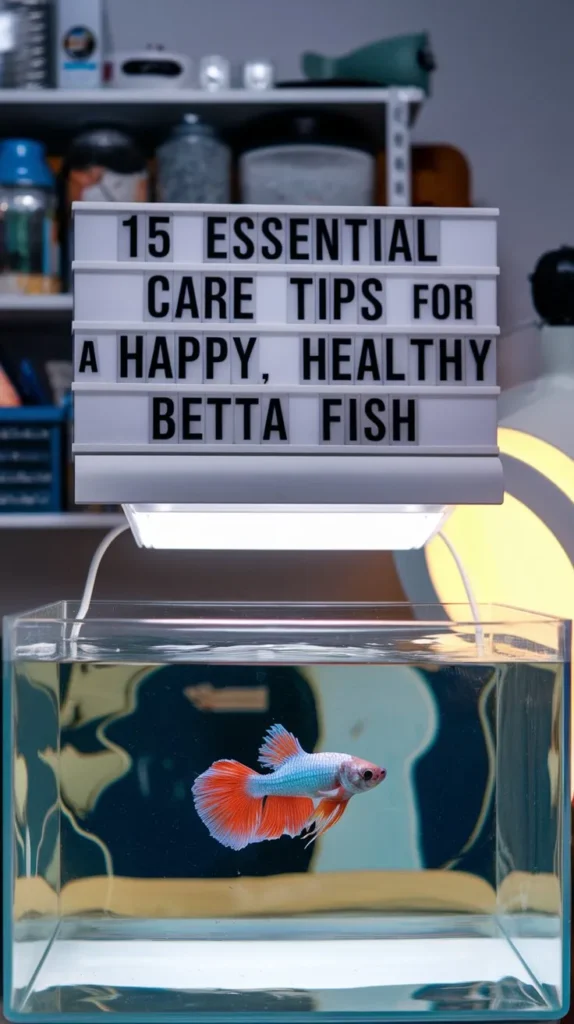

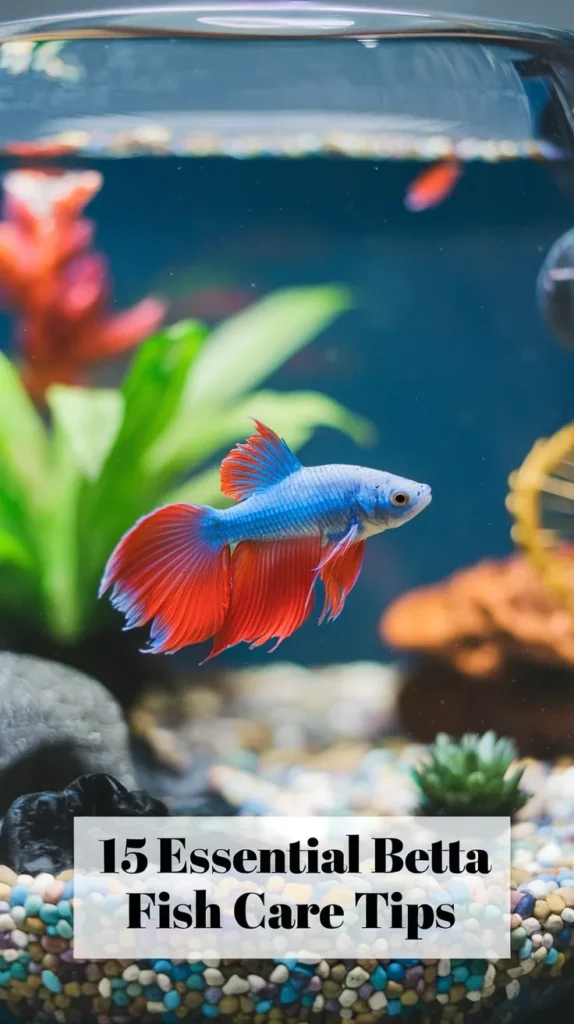
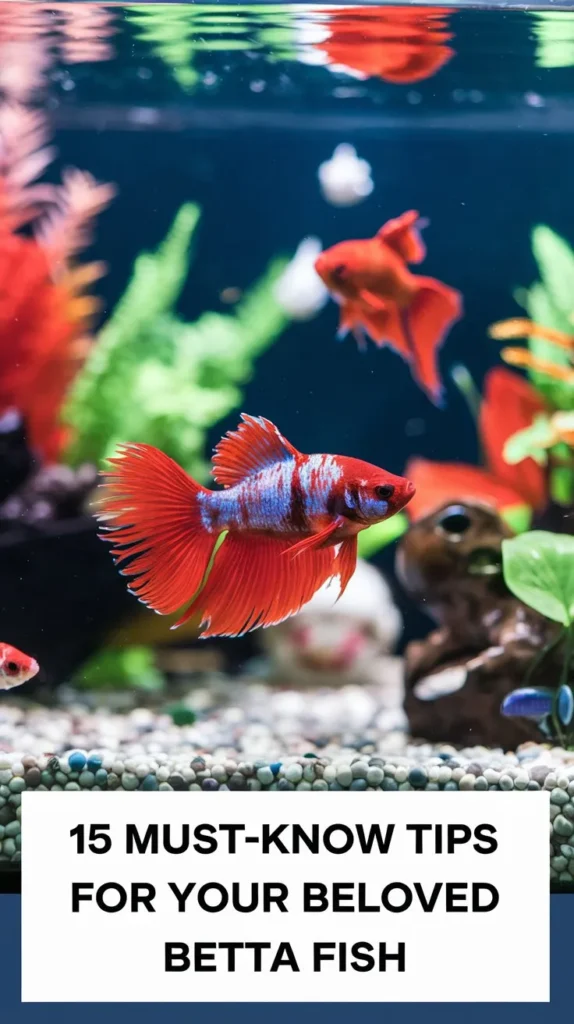

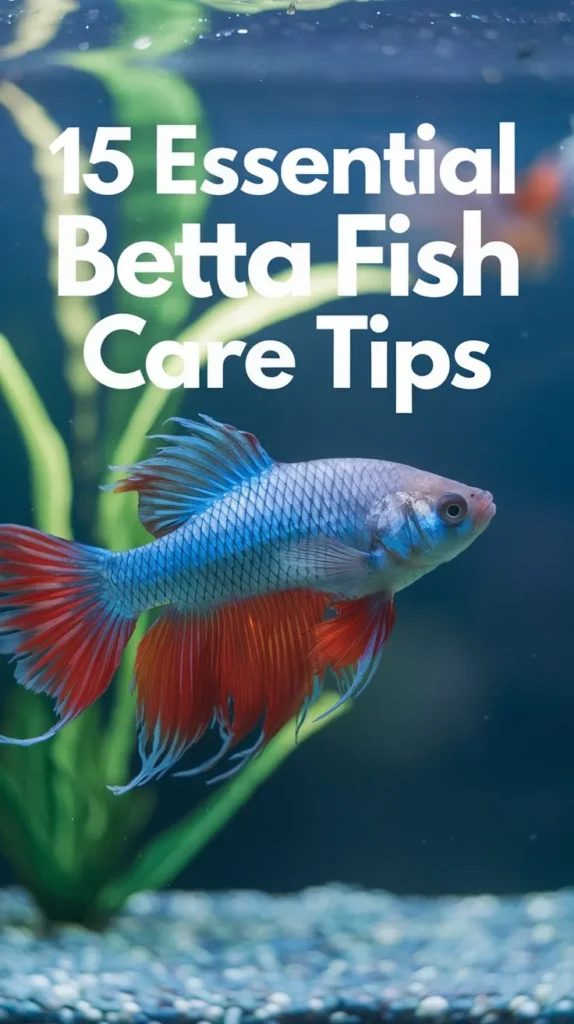
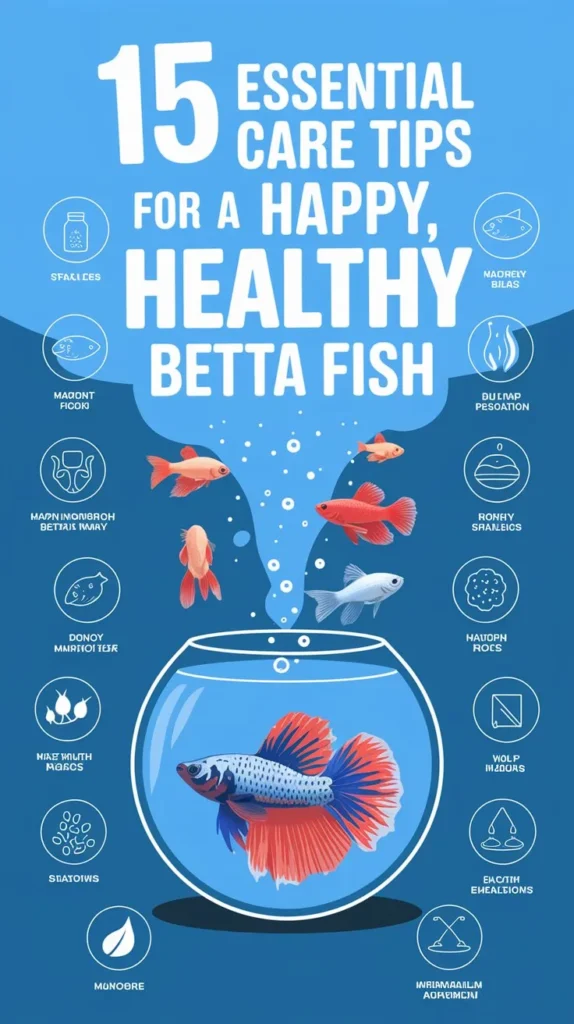

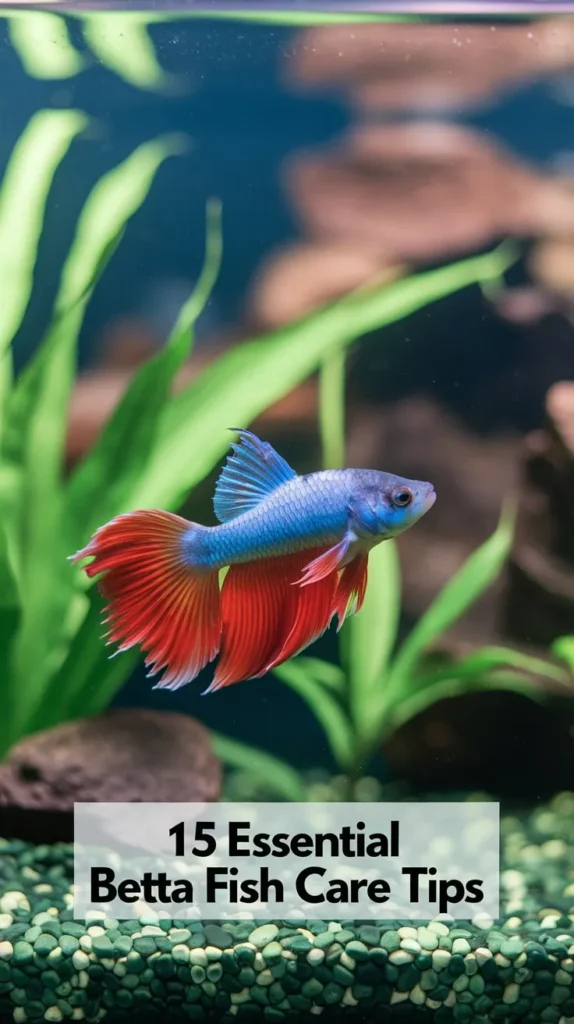

Hello, I’m Aria Cooper, the heart and soul behind Swimmy Buddies. As a devoted fish aficionado, I share my aquatic adventures and expertise to inspire your own underwater explorations. 🐠🌊

